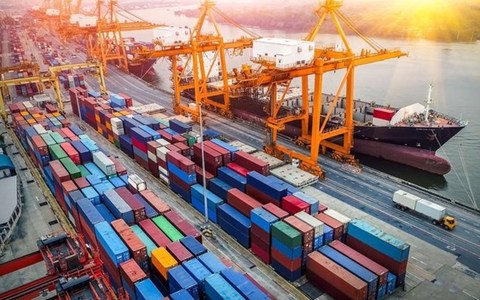 |
|
Viet Nam runs a deficit of $1.7 billion in July, bringing the figure in seven months to $2.7 billion. |
On seven-month calculation, the figure reached $185.33 billion, marking a yearly rise of 25.5 per cent. Of which, $48.52 billion was from domestic economic sector, up 14.6 per cent and the remaining from foreign-invested sector, inclusive of crude oil, up 29.9 per cent.
Twenty-seven goods groups earned over $1 billion from export, or 90.2 per cent of the total. Five of them brought home more than $10 billion, equivalent to 57.8 per cent.
Export of materials and mineral resources was estimated at $1.87 billion, up 1.4 per cent annually while that of processed industrial goods was $164.89 billion, up 27 per cent. Agro-forestry products raked in $13.65 billion and fisheries $4.92 billion, up 16.7 per cent and 12 per cent, respectively.
The US remained Viet Nam’s largest importer with turnover hitting $53.6 billion, up 37.4 from the same period last year. It was followed by China $28.7 billion, up 24.2 per cent and the European Union $22.5 billion, up 15.5 per cent.
According to the GSO, imports in July was estimated at $28.7 billion, up 3.8 per cent month on month and 29.9 per cent year on year.
Seven-month imports rose by 35.3 annually to $188.03 billion, $66.31 billion of which were from domestic sector and the remaining from foreign-invested sector.
Over $1 billion were spent on 31 goods each, or 87.5 per cent of the total imports.
China was the largest exporter of Viet Nam with a value of $62.3 billion, up 48.5 per cent annually. It was followed by the Republic of Korea $29.7 billion, up 19.9 per cent; ASEAN $24.7 billion, up 48.2 per cent; and Japan $12.6 billion, up 13.8 per cent.
The country ran a deficit of $1.7 billion in July, bringing the figure in seven months to $2.7 billion.
To boost production and exports, the Ministry of Industry and Trade pledged to tap opportunities from free trade deals, step up export promotion activities post-pandemic, as well as continue developing energy, mechanical engineering industries.
Experts show optimism about balance of trade
Deputy Minister of Industry and Trade Do Thang Hai held that the majority of spending was on materials, signalling the rapid recovery of domestic production. Many production facilities have received orders to keep them busy until the end of the third quarter or the whole year, causing an increase in imports of materials, he said.
Besides, economists asserted that a number of businesses have increased imports of materials for reserve to take advantages of low prices in current period, so that they will have enough materials despite COVID-19 impacts.
With strong imports of materials for production and the rapid recovery of the global market, Viet Nam will record growth in exports in the rest of the year to balance trade soon, they said.
Deputy Director of the Import-Export Department under the Ministry of Industry and Trade Tran Thanh Hai, export activities are normally busier in the last months of the year. However, in order to complete the target of 4-5 per cent growth in export revenue in 2021 and trade surplus for the whole year, it is necessary to make stronger economic breakthroughs.
He advised businesses to make full use of advantages from signed free trade agreements (FTA) to increase exports, especially of strong products such as farm produce, garment and textile. He pledged that the ministry will support them in seeking markets and partners, removing administrative obstacles and promoting e-commerce.
Dr. Nguyen Thuong Lang from the National Economics University held that along with grasping opportunities from FTAs, Vietnamese firms should continue to improve their product quality.
General Director of May 10 Garment Company Than Duc Viet underlined the need for businesses to adapt to the ‘new normal’ situation to rise.
With joint efforts of authorised agencies and businesses, experts are optimistic about the balance of national trade in the rest of the year.
Source: VNS